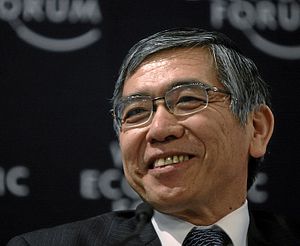The Japanese yen has been weakening against the U.S. dollar since 2013, depreciating by more than one-third from its peak in November 2011. Further depreciation may cause tensions with export-heavy economies in its neighborhood, and even with the U.S., hindering the progress of the Trans-Pacific Partnership (TPP). Despite the massive currency depreciation, which make Japanese products more competitive overseas, it is uncertain whether or not the economy can retain its growth momentum.
The Bank of Japan, the central bank for the world’s third largest economy, elected to expand its quantitative-qualitative easing (QQE) in October. The decision was approved by its board members with the slim margin of five-to-four. Excluding the governor and two deputy governors, the majority was against further easing. The move came as a surprise to the market, and the Japanese yen depreciated by 1.8 percent during trading on the day, and by 3.6 percent over the following week. The additional easing was clearly welcomed by the equity market, as the Nikkei 225 index soared, rising 3.8 percent on the day and 2.7 percent over the following week. Haruhiko Kuroda, the governor of the Bank of Japan, certainly knows how to go beyond market expectations, his most notable example coming at his first monetary policy meeting (MPM) in April 2013.
However, the dramatic expansion in the monetary base target underscores the central bank’s desperation to achieve its inflation target of 2 percent. We have seen little evidence of accelerated credit creation attributable to the monetary easing, and the only path remaining for the BOJ to achieve the goal is through depreciation of the currency. By increasing the import price, the BOJ may be able to push inflation up.
The timing was, with the wisdom of hindsight, understandable. The preliminary GDP figures of the last quarter would be announced on November 17, just before the next MPM. If growth had declined, as in fact it had, additional easing in November would not have been quite as effective as it was in October. Moreover, it was believed at the time that Prime Minister Shinzo Abe would, in October, announce an increase in the consumption tax from 8 percent to 10 percent, as previously planned. A governor with his origin in the Ministry of Finance stepped into support this plan with pre-emptive monetary easing.
The opposition, which accounted for four out of nine members on the monetary policy board, is still skeptical about the additional easing. Takehiro Sato, a board member and a former senior economist at Morgan Stanley, voted against the proposal in October. He stated in a recent speech that the decline in the commodity market would, overall, be positive for domestic economic activities, but the central bank should not have acted due to concern about downward pressure on prices. He added that as the depreciation of the yen increases, the import price reduces the profits of SMEs and non-tradable sectors as well as real household incomes.
The opposition extends beyond the BOJ and into Japan’s neighbors. South Korea struggles with a weak yen, as its exporters, led by electronics and automobile makers, compete with Japanese rivals. South Korea President Park Geun-hye denounced the rapid depreciation of the yen at the G20 meeting in Australia last month. The Bank of Korea has cut its policy rate three times since May 2013 from 2.75 percent to 2.00 percent, following the QQE started by the BOJ. The KOSPI index is unchanged from the level two years ago, whereas the Nikkei is up almost 70 percent since the end of 2012.
Nor should the U.S. be overlooked. If the yen continues to depreciate, American companies in the auto and tech industries will not be silent. Their complaints will make it even harder to conclude the TPP, a deal that is critical to the future of the Japanese economy. While it is true that domestic consensus in Japan is open to aggressive monetary easing, the BOJ should not ignore the risk of international criticism.
The bottom line is that Japan should not be pursing zero-sum, beggar-thy-neighbor policies. It would be different if monetary easing stimulated economic activities by reducing borrowing costs. The reality is, however, tougher for the BOJ, and due to the broken link between the money supply and the monetary base, the central bank is no longer capable of pumping blood into the body of the economy. The financial markets in Japan died long ago: Government bond yields are negative for the two-year term and below 0.1 percent for the five-year term. It is thought that Citigroup will soon reach a deal with Sumitomo-Mitsui Financial Group to sell its retail banking business in Japan, and the Royal Bank of Scotland just announced its retreat from fixed income trading in Japan and reduced its local headcount by almost 90 percent. Monetary easing no longer seems to be doing the trick.
Instead, real structural reforms are needed, but no one is delivering. As was universally expected, the Liberal Democratic Party won the election over the weekend. The election will very likely change nothing. Yet it is obvious that the current situation is not sustainable. Without real change, Japanese will need to accept a lower quality of life as their purchasing power steadily declines. The current QQE could well be a friendly hint of what will happen in the near future.
Keita Miyaki is a consultant at the World Bank Group, and previously worked for the ASEAN+3 Macroeconomic Research Office and PIMCO.

































